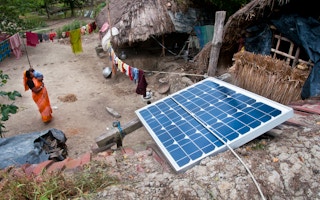The usual model of development for emerging economies is to rely on fossil fuels to meet rising power demand and later to switch to cleaner sources of energy. But just as antennae have enabled countries to enjoy the benefits of mobile telephony without the need for extensive telecommunications infrastructure, so advances in solar technology have the potential to power communities without the need for costly new power plants nearby.
To continue reading, subscribe to Eco‑Business.
There's something for everyone. We offer a range of subscription plans.
- Access our stories and receive our Insights Weekly newsletter with the free EB Member plan.
- Unlock unlimited access to our content and archive with EB Circle.
- Publish your content with EB Premium.
Growing demand for energy traditionally leads to more power plants being built, usually to burn coal and natural gas. This provides much-needed electricity, but it creates the problem of increased CO₂ emissions, which will have a tremendous impact on the environment in the future.
With solar power approaching so-called “grid parity” in many countries, regions such as Southeast Asia, with plentiful sunshine and remote communities, would do well to take advantage of this abundant and emissions-free energy source.
“
The installed photovoltaic capacity around the world has quadrupled since 2009 to over 130 gigawatts, which is enough to meet all power demands in Singapore for 13 years
Routing electricity to remote towns and villages from power plants can be very costly and communities typically have to wait years for the power to start flowing. These communities often rely heavily on diesel generators to meet their power needs. Small solar farms solve this challenge by bringing the power source closer to home, minimizing or completely replacing the use of generators that run on expensive diesel fuel. This would bring long term economic benefits to those communities through an abundant source of energy that costs absolutely nothing.
Solar energy also has enormous potential in urban areas. Energy consumption in buildings can be optimized significantly by integrating on-site solar generation with energy-efficient technologies such as intelligent controls that manage heating and cooling, as well as lighting. Additionally, as electric vehicles begin to make their way into cities in Asia, there will be a need to integrate charging infrastructure into the building environment.
Small wonder that the recent growth of solar has been astonishing. The installed photovoltaic capacity around the world has quadrupled since 2009 to over 130 gigawatts, which is enough to meet all power demands in Singapore for 13 years.
Being a global leader in power and automation technologies which enable energy efficiency, sustainable transportation and renewables, ABB is convinced that solar energy will play an important role in decoupling economic growth from environmental impact. With a presence in the solar industry dating back to the 1990s, we have long been committed to the industry. A clear indication of this is the US$1 billion investment made last year in acquiring the world’s number two solar inverter manufacturer, Power-One.
In Southeast Asia, ABB has been involved in several solar installations. In Papua in Indonesia, our solutions are installed at the world’s highest solar power plant, situated 3,000 metres above sea level. In Singapore, our technology is used in several solar projects, which includes our very own plant in Tuas, while our inverters can be found across the region. We have also provided equipment and plant automation solutions at the world’s largest thin-film solar plant in Lopburi, Thailand.
Looking forward, we see ample opportunity for countries all over the region to adopt solar as an affordable source of renewable energy. Let’s not allow all the energy that hits the surface of the earth to go to waste.
Haider Rashid is region president of ABB in South Asia.








